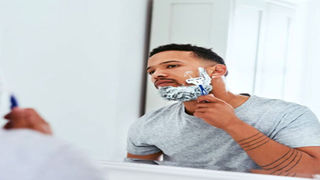
If you want a good shave with no razor burns and shaving rash; then consider investing on a high quality razor. PHOTO/COURTESY
|Healthy Living
Prime
How to maintain and keep your beard healthy
What you need to know:
- Growing a great beard is something to be proud of.
- But the journey does not end once the desired length or style has been achieved. You need to know how to keep your beard healthy and fresh.
A well-groomed beard defines a man’s personality and enhances their masculinity. Unlike hair, your beard requires extra attention since it is prone to getting a lot dirtier since you keep touching it and is prone to spills from drinks or food.
Brush and comb
Brushing the beard is important because it removes any dead skin cells on your face and promotes circulation in order to keep your hair looking healthy.
According to Dr Edward Ogwang, a dermatologist, a boar bristle hair brush is ideal because it will distribute the natural oils of your skin throughout your beard. It is also suitable for moisturising and cleansing.
“Use the brush to exfoliate and bring any beard ruff to the surface to make washing easier. Brush slowly against and across the grain for best results. A beard comb will also help keep all those stray hairs in place and give it a neat appearance,” he says.
Trim
After brushing the beard, it is time to trim it. First, cut the hairs that are too long and make sure everything is even. This can be done every two weeks or more, depending on how fast your beard grows. Trimming can be done at home or at a barber’s shop.
There are many types of trimmers available; choose one best suited to your needs.
For your mustache line, use clippers or scissors to get rid of any unwanted hair, particularly just under and around your nose as well as the hair inside your nose. Thereafter, comb your mustache straight down and remove any hair below your lip line. Hair that grows longer is a trap for lunch.
Beard oil is a must-have for any man with a moderately short beard. It keeps the skin underneath moisturised. Dr Ogwang says the best oils for beard growth include olive oil, coconut, sunflower, castor, jojoba, argan, or avocado oils. Apply a few drops of beard oil to your hands and massage it into the beard.
Washing
As part of routine care, Bill Magnifique washes his beard with shampoo to keep the skin underneath clean and healthy and prevent beard ruff from forming.
“However, it is important that you use lukewarm or cold water because hot water dries your skin and causes beard ruff. I also avoid over washing as it strips away the natural oils of the skin and beard,” he says.
To prevent damage to the skin, pat your beard dry as opposed to vigorously toweling it dry. Use a high-quality face towel that is clean and soft, because a rough towel causes irritation to your skin, which could lead to ingrown hairs.
Shaving
Shaving is essential for beard hygiene because it makes moisturising the skin easier by reducing the amount of dead skin cells on it. On average, it may take you about ten minutes to complete a thorough shave, including washing your face with warm water. To keep your skin looking its best, shave frequently. Shaving also reduces acne by unclogging hair follicles, which cause acne.
“If you are prone to acne, then shaving at least twice a week is recommended for the sake of reducing oil and keeping bacteria from accumulating on your face. When hair is left on the skin for long periods of time, it blocks pores and prevents hair from growing out of these pores,” Dr Ogwang says.
How to prevent irritation
According to Dr Ogwang, applying excessive pressure to your razor when shaving causes irritation.
“Shaving against the grain or taking too many passes can cause irritation on your skin. Therefore, use less pressure and since hairs grow in different directions on everyone’s face, always remember to shave in the direction your hair grows,” he says.
Use high-quality clean shaving blades and consider changing them as often as you shave. If you already have the burn, avoid shaving the affected area and then apply natural oils or razor burn cream.
“Shaving with dull blades can make the process more difficult and lead to infections, ingrown hairs, and irritated skin. It is, therefore, important that you change blades every week or two, depending on how often you shave,” Magnifique advises.
Men with coarse or curly facial hair are more likely to develop ingrown hair. To prevent this, always use a clean, sharp razor and shave in the direction your hair grows, not against it and also, exfoliate the skin more frequently.
One of the commonest mistakes men make while shaving their beard is shaving too quickly and using too many shaving products at a time. This may cause irritation for some sensitive skin types. The best approach is to use one product at a time.
Dead-skin
Dead skin (dandruff), makes your beard look dirty, especially when combed, leaving a faint dusting of dead skin and other unappealing specks on your chest.
“To treat this, avoid using hot air if you are blow drying because it dries up the skin. Use the coolest setting available or pat dry with a towel. Remember to exfoliate pre-shower with a boar bristle brush and apply beard oil post-shower to lock moisture in and prevent dryness,” Dr Edward Ogwang, a dermatologist, advises.
Hot showers dry out your skin, causing flakiness. If beard ruff is persistent, consider reducing the temperature to lukewarm water for washing your hair and beard.




